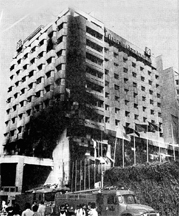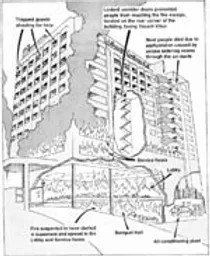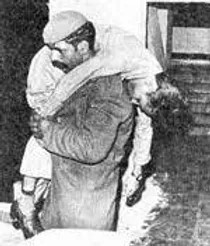
Many had seen it happen in The Towering Inferno. Some had read about the 1982 fire in the MGM Grand casino at Las Vegas that consumed 468 lives. But, for most people in India, disasters of that variety were almost an alien proposition, belonging to the fast-moving, modern western world. The illusion was shattered rudely on January 24.
Suddenly, the kind of horrifying spectacle that many in India thought belonged entirely to the unreal world of Hollywood films became a real proposition where it was least expected, in a spanking new five-star hotel standing proudly in south-western Delhi flanked by the exclusive Vasant Vihar locality on one side and the upper-middle class Munirka Enclave on the other.
Within a few hours, the lower half of the nine-story Hotel Siddharth Continental, owned by a private firm called Jaiprakash Associates, was reduced to a sooty, blackened shell and the casualty count was mounting to finally touch a mind-boggling figure of 37 dead and 46 injured. In one cruel blow, the most disastrous fire in the capital’s history had exposed the inadequacy of its fire-fighting machinery and the fire risks literally built into the numerous high-rise buildings which have mushroomed in Delhi.
Coming at the height of the city’s busy tourist season the disaster also put the Indian tourism industry through a traumatic ordeal by fire. There was no getting away from the fact that many of the victims were foreigners, including tourists who customarily descend on Delhi in winter. Besides the usual complement of Indian businessmen, large groups of Russians and Japanese had checked in. Most of the remaining rooms had been taken up by a pharmaceutical company in far for a conference. To add to the embarrassment there was the odd diplomat couple, staying at the hotel till more permanent lodgings could be found.
Many of them never made it out of the hotel alive. Among the victims of the blaze that first began in Mandala, the banquet hall in the basement, and then consumed the lobby and first three floors of the hotel were some representatives of the pharmaceutical company. West German diplomat Guenter Gerlach and his wife were discovered dead in their beds.
The body of a young Australian girl Eva Funnel was the last to be carried out of the smoldering hotel nearly ten hours after the fire had started. Also among the dead were: V. Subramony, managing director of the Rourkela Steel Plant, Argentine diplomat, J.J. Rinaldini, Kirloskar company executives R.B. Naik and A.S. Limaye, three Japanese experts working with Maruti, a couple from Bahrain who died leaving their two daughters, aged seven and live in a state of delirium, two Iraqi women, two Englishmen, and a victim each from Pakistan, the US, France, and the USSR.
Identification was not made easier by the fact that the registration books and records kept in the lobby had been destroyed in the fire. While going through the rooms the police recovered some passports, including that of an American, and efforts were underway to trace its owners. Most of the foreigners staying in the hotel were either vacationing or on a business trip.
Till three days after the disaster, the evidence of the panic and the desperate longing for life that must have seized those in the burning concrete monolith still hung out of many windows, long makeshift ropes made up by stringing together bed sheets and linen, a device that brought instant death to some when loosely-tied knots slipped and opened.
The Mohanty family, in Delhi on its way to Montreal, was one to run into mixed luck. Jai Gopal Mohanty, a biochemistry researcher at Montreal University was busy, along with his wife and two sons, aged 12 and 8, packing for the 5 a.m. flight to Montreal when he suddenly noticed smoke sneaking into the room “perhaps from the false ceiling” and realized that something was wrong. “We rushed out, but the corridor was full of smoke and we felt suffocated, so my wife said let us rush back to the room,” he now recalls with a forlorn look in his eyes. Soon the family had the mortification of seeing that the ladder put up by the fire brigade people was too short to reach their eighth-floor room. Says Mohanty: “At this stage people below shouted to us to use bedsheets to get down and we sent the children first.” He succeeded in lowering his two sons to the ledge below from where they were picked up and rescued. But disaster followed. Mohanty fell unconscious halfway to safety but was rescued. But his wife choked to death in the room.
The superstructure of the hotel still stares down bleakly at the vast expanse of desolate blocks of flats filling up the horizon in the south-west, the direction from which the murderous breeze came in on that fateful evening, fanning the flames and, more importantly, churning up large clouds of smoke that choked the nostrils and blinded eyes of the helpless guests and firemen giving the sense of panic a suicidal quality. Three persons jumped to their death from windows. Amidst all the controversy, there is no doubt on one point, that most people died of asphyxiation.

Large-scale asphyxiation was possible because of the panic created by the fact that the hotel was plunged into darkness. The first casualty of the fire was the lighting. Either they were switched off or they went off and the stand-by generator in the basement never came on. The result was that even those guests woken by the smoke groped about the hotel corridors trying to locate the fire escape. The doors leading to the fire escape were locked and in the dark, the helpless guests could not locate the keys kept in glass cases along the corridor.
Asked a fire service officer: “Anywhere in the world, you will find good hotels having separate power supply systems for the fire alarms, there was none here. There wasn’t even an internal public address system on which we could tell the inmates what precautions to take.” In desperation, the firemen and some hotel staff members even though in terms of calling up each inmate on the internal telephone exchange individually but the phone operator had gone off to sleep along with the keys. Firemen themselves were hampered by the lack of snorkels and cushioning nets on which they could get people to jump.

In retrospect, a lot of people could also have survived had they had any previous training in fire-fighting – something most Americans learn. Four of them, executives of the Gillette company, survived merely by consigning themselves to fill up bathtubs after sealing all the main points of ingress for smoke and flames with wet linen and towels. They waited there till help came. “Most people could have survived if they just tried to breathe through wet towels or linen, or had they not made the error of opening windows and doors for an instant and then shutting them in panic, thus trapping the deadly smoke in the rooms,” a fireman said.
These afterthoughts, now, have no meaning. But one mystery that needs to be solved is what caused the fire in the first place. The first suspicion was on the power supply system but others talk in hushed tones of sabotage, a theory floated by the hotel management.
Hotel General Manager J.S. Malhotra and architect S. Jain tended to think it was sabotage. Malhotra said: “Sabotage cannot be ruled out.” Said Jain: “I think it was sabotage.” Both found it difficult to understand how in a matter of 15 to 20 minutes the fire had engulfed four floors. “It’s difficult to visualize, there was no wind and the air-conditioning was not working. How did the smoke get into all the rooms so fast?” asked Jain.
He also said there was no connection between the (air-conditioning) ducts of the banquet area in the basement, where the fire is believed to have started, and the ducts in the upper floors where the guest rooms are located. But fire brigade officers said the smoke had risen and probably entered the rooms through the ducts from the lobby, the service floor above it, and the third floor, where the fire raged.
Even Minister of State for Civil Aviation Jagdish Tytler, who visited the site, seemed to have a fixation on the sabotage theory. He was informed by fire brigade officials that the body of a hotel steward Shekhar had been discovered in the banquet area where the fire is believed to have started. He questioned the firemen on how they could be sure the charred body was that of a staff member and not of a saboteur. It was only after they told him that the victim’s name plate was still on his chest and the papers in his pocket and watch he was wearing was identified by his colleagues that he relented. The fire brigade men informed Tytler and Works and Housing Minister Abdul Ghafoor who also spent some time examining the wreckage of the banquet area, that several gas cylinders were stored in a kitchen near the banquet area and some of them were suspected to have been leaking.
But the cause of the fire is a relatively insignificant aspect of the disaster at the moment. The key question, on the other hand, is how adequate were the fire precautions and survival equipment in the hotel. It is well-known now that the smoke alarm did not function, that the hotel did not have sprinklers nor a system to efficiently guide the inmates to the fire-escape. And it is not as if the inadequacy of the hotel’s fire-fighting equipment was not known to the authorities. Since 1982 the hotel had been functioning on temporary licences of the kind granted to many other five-star hotels in Delhi, including the Government-owned Ashok and Kanishk, and the new Meridien on Janpath, none of which meet safety requirements.
This cavalier attitude upsets the Delhi firemen a great deal who say they get the blame every time a major fire takes place while nothing is done to enforce safety regulations. “Once a fire begins, no fire brigade in the world can put it out without any damage. But casualties of this kind only take place due to ignorance and callousness,” said a senior Delhi fire service officer. The fire also exposed the Delhi Administration’s own callous disregard for the fire risk in the numerous high-rise buildings in Delhi. In early 1983, there was a furore after the Gopala Towers tire and it led to the formation of a committee headed by retired major-general H.C. Singhal which drew up a list of over 200 multi-storey buildings with a fire risk.
Hardly one of the committees’ recommendations has been implemented so far. Delhi firemen say that even more than the hotels the fire threat today exists in commercial buildings which are very heavily populated during working hours when the electric systems also have a massive load, particularly during summer when the air-conditioners are on. “One of Singhal committees’ recommendations was that at least 450 more men should be added to the Delhi fire brigade. Has anything been done about that?” asks S.K. Dheri, the city fire chief.
Sure enough, even this time, the Government’s immediate reaction to the tragedy was the formation of yet another committee to investigate into the fire. Union Tourism Minister H.K.L. Bhagat also flew in from Bombay and ordered a review of all the five-star hotels in the country. But this time in the background of a perennial terrorist threat in the capital there is a new sense of urgency. And unless it results in a substantial improvement in safety conditions in the high-rise building the capital could see many more morbid encores of the tragedy.
